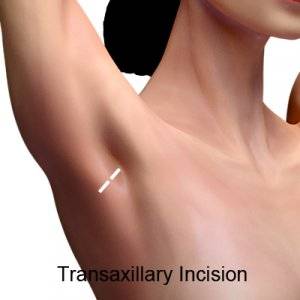5 S’s Of Breast Augmentation – Scar Location Options

Women interested in breast augmentation have many different factors to consider. I created the “5 S’s of Breast Augmentation” blog series to help prospective patients navigate this process. The 5 S’s are: substance (silicone versus saline versus fat), scar location (inframammary, periareolar), surface characteristics (textured versus smooth), size (volume) and shape (round versus anatomic).
In this post we will cover scar location (or incision options):
Performing breast augmentation surgery requires that an incision be made, by the surgeon, somewhere on the patient. Once the surgical approach is completed and the implant is in place, the incision is closed with sutures. This incision typically heals into a fine scar over the course of several months. The scar location is an important matter to discuss with prospective breast augmentation patients. This article outlines the four available options, with some information about each one.
Inframammary Incision

The final scar lies within the natural breast fold. The length can vary from an inch to an inch and a half depending on the type of implant being used (cohesive gel implants require a longer incision for placement). This is the most common incision used among board-certified plastic surgeons. It is considered the most reliable approach in breast augmentation surgery.
Periareolar Incision

The scar is placed at the edge of the areola, usually the inferior portion (within the bottom half). This placement can provide excellent camouflage as the scar exists at a natural border and may not be easily seen on casual glance. It is an excellent choice in women who are undergoing a breast lift at the same time. Some studies suggest an increased risk of capsular contracture with this approach, as well as an increased risk of nipple sensation and lactation issues compared with the inframammary approach.
Transaxillary Incision

This approach through the armpit is more technicaly demanding than the previous two approaches. Most surgeons agree that the use of an endoscope is beneficial to improve visualization, especially if the implant is to be placed under the pectoralis major muscle and if silicone implants are used. Though the idea of having a scar totally hidden from view and remotely located from the breast is appealing, there are some drawbacks that make this approach less common than the inframammary or periareolar approaches. Disadvantages include increased length of surgical time, and the need to place a different incision should the patient need further breast surgery such as a capsulectomy.
Transmbilical Incision

A small scar placed at the belly button. This approach is viable only for saline implants, because they are empty when placed by the surgeon. Silicone implants should not be placed through the belly button. The vast majority of board-certified plastic surgeons do not offer this approach in their practices.

I’m using Dermalmd scar treatment serum on my tummy tuck and breast augmentation scar. I’ve been using it for 2 weeks and already see a difference. I put it on and then cover it with my silicone sheets. I recently just ordered another one-don’t want to run out! It’s somewhat a thick consistency which I prefer because I feel it stays on the scar area.
I’ve also read in this article that there are two main incision locations that surgeons considered one at the base of the breast and the other one is at the lower edge of the areola. Everyone scars differently, so I guess it’s always hard to know exactly what will work for everyone during the healing process. I would suggest that we should follow what our surgeons recommendations.